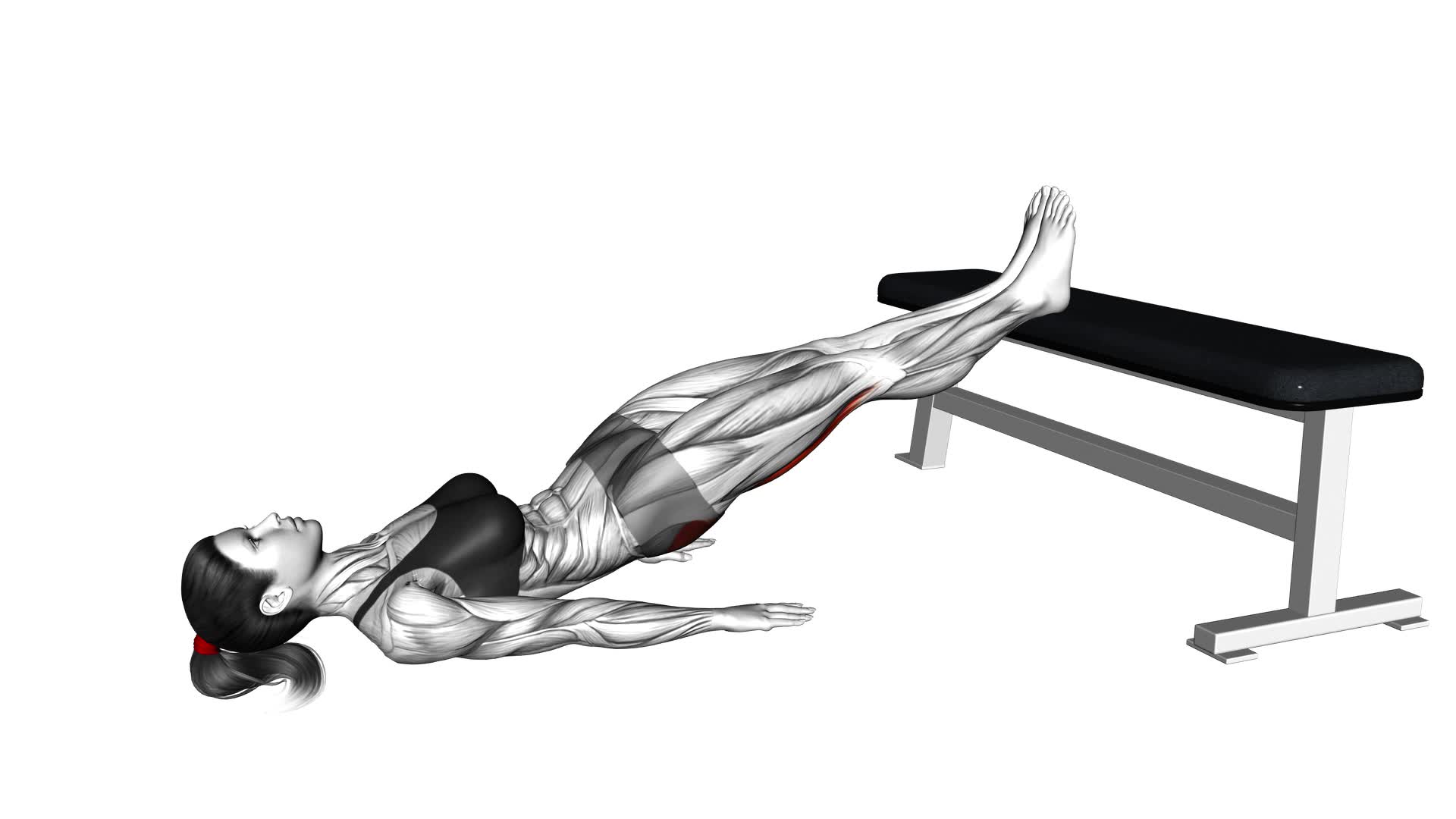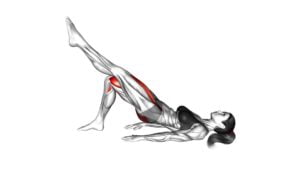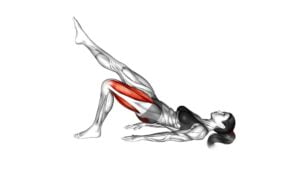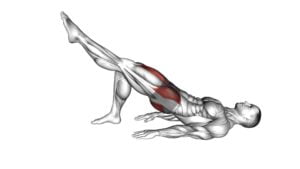Straight Leg Glute Bridge (female) – Video Exercise Guide & Tips

Are you looking to strengthen and tone your glutes? The straight leg glute bridge is the perfect exercise for you!
Watch This Exercise Video
In this video exercise guide, we'll show you the proper form and technique to maximize your results.
With variations to target different muscle groups, you can customize your workout to fit your needs.
Avoid common mistakes and get the most out of your glute bridge routine with our helpful tips.
Let's get started on sculpting those glutes!
Key Takeaways
- The straight leg glute bridge strengthens the glute muscles and improves athletic performance.
- It helps prevent injuries and targets and activates the glute muscles, hamstrings, and core muscles.
- Proper form and technique include avoiding hyperextending the lower back and pressing through the heels instead of the toes.
- Variations such as single-leg straight leg glute bridge and resistance band straight leg glute bridge can target different muscle groups and increase intensity.
Benefits of the Straight Leg Glute Bridge
One benefit of the straight leg glute bridge is its ability to strengthen your glute muscles. Glute activation is a crucial aspect of any strength training routine, as strong glutes not only improve your overall athletic performance but also help prevent injuries.
By performing the straight leg glute bridge, you specifically target and activate your glute muscles, helping to build strength and stability in this area. This exercise involves lying on your back with your knees bent and feet flat on the ground, then lifting your hips off the floor while keeping your legs straight.
This movement engages your glutes, hamstrings, and core muscles, providing a comprehensive lower body workout. The straight leg glute bridge is an effective exercise for strengthening your glutes and improving your overall lower body strength.
Incorporating this exercise into your strength training routine can help you achieve better athletic performance and reduce the risk of injury.
Proper Form and Technique
To perform the straight leg glute bridge correctly, lie on your back with your knees bent and feet flat on the ground. This exercise is a great way to strengthen your glutes and core muscles.
However, there are some common misconceptions about proper form and technique that you should be aware of.
One common misconception is that you need to lift your hips as high as possible during the bridge. While it's important to lift your hips off the ground, you don't want to hyperextend your lower back. Instead, focus on squeezing your glutes and engaging your core as you lift your hips.
Another misconception is that you need to keep your legs completely straight throughout the exercise. However, if you're a beginner or have tight hamstrings, it's okay to have a slight bend in your knees. This modification can help you maintain proper form and prevent strain on your lower back.
Remember to keep your feet hip-width apart and press through your heels as you lift your hips. Avoid pushing through your toes, as this can lead to unnecessary strain on your knees.
Variations to Target Different Muscle Groups
To target different muscle groups, try incorporating variations of the straight leg glute bridge into your workout routine. These variations can help you engage and activate specific muscles in your lower body, providing a more well-rounded workout.
One advanced modification you can try is the single-leg straight leg glute bridge. Instead of using both legs, lift one leg off the ground and perform the glute bridge with just the other leg. This variation adds an extra challenge to your glutes, hamstrings, and core muscles.
Another variation to consider is the resistance band straight leg glute bridge. By placing a resistance band around your thighs, just above your knees, you can add an extra level of resistance to the exercise. This targets your glutes and outer thighs more intensely, helping to improve hip stability and strengthen the muscles responsible for hip abduction.
Incorporating these advanced modifications and resistance band variations into your workout routine can help you target different muscle groups and achieve a more comprehensive lower body workout. Remember to start with proper form and gradually increase the intensity as your strength and stability improve.
Common Mistakes to Avoid
To avoid hindering your progress and maximizing the effectiveness of the straight leg glute bridge, it's important to be aware of common mistakes that you should steer clear of. Here are some common errors to watch out for and tips on how to correct them:
- Raising your hips too high: It's important to maintain proper form throughout the exercise. Avoid lifting your hips too high, as this can put excessive strain on your lower back. Instead, focus on engaging your glutes and lifting your hips just enough to create a straight line from your shoulders to your knees.
- Allowing your knees to fall inward: Keep your knees in line with your hips and ankles throughout the movement. Allowing your knees to collapse inward can diminish the effectiveness of the exercise and potentially lead to knee pain. Focus on pushing your knees outwards to activate your glute muscles.
- Not fully extending your hips: Make sure to fully extend your hips at the top of the movement. This means squeezing your glutes and lifting your hips as high as possible without compromising your form. Fully extending your hips will help you target and activate your glute muscles effectively.
Tips for Maximizing Results
To maximize your results, make sure you're incorporating these tips into your straight leg glute bridge routine.
First and foremost, pay attention to your diet. Eating a balanced and nutritious diet is essential for achieving optimal results. Make sure to include plenty of lean protein, fruits, vegetables, and whole grains in your meals. This will provide your body with the necessary nutrients for muscle growth and recovery.
In addition to diet tips, incorporating resistance into your straight leg glute bridge routine is crucial. By adding resistance, such as using resistance bands or weights, you can challenge your glute muscles even more and stimulate further muscle growth. Start by using lighter resistance and gradually increase as your strength improves.
To perform a straight leg glute bridge with resistance, lie on your back with your knees bent and feet flat on the ground. Place a resistance band just above your knees or hold a dumbbell on your hips. Lift your hips off the ground, squeezing your glutes at the top, and then lower back down. Repeat for the desired number of repetitions.
Remember to always maintain proper form and listen to your body. If you experience any pain or discomfort, stop immediately and consult a fitness professional.
Frequently Asked Questions
How Many Sets and Reps Should I Do for the Straight Leg Glute Bridge Exercise?
For optimal results, aim to do 2-3 sets of the straight leg glute bridge exercise. Start with 10-12 reps per set and gradually increase the reps as you get stronger. Remember to focus on engaging your glutes and maintaining a straight line from your shoulders to your knees.
To add variation, you can try single-leg straight leg glute bridges or use a resistance band for added resistance.
Stay consistent and listen to your body to see the best results.
Is It Necessary to Use a Resistance Band While Performing the Straight Leg Glute Bridge?
Using a resistance band during the straight leg glute bridge can offer several benefits. It adds extra resistance to your glutes, making the exercise more challenging and effective. The band also helps activate the hip abductors, which can improve stability and prevent injuries.
However, using a resistance band isn't necessary to perform the exercise. If you don't have a band or prefer an alternative, you can still work your glutes with other exercises like hip thrusts or single-leg glute bridges.
Should I Perform the Straight Leg Glute Bridge Exercise Before or After My Cardio Workout?
To get the most out of your workout, it's best to perform the straight leg glute bridge exercise after your cardio session. This allows your muscles to be warmed up and ready for the exercise.
Doing it post workout also helps to activate and strengthen your glutes, which can benefit your overall fitness goals.
Can I Incorporate the Straight Leg Glute Bridge Into a Full-Body Workout Routine?
Yes, you can definitely incorporate the straight leg glute bridge into a full-body workout routine.
It's a great exercise for glute activation and offers many benefits.
By including glute bridges in your routine, you can strengthen your glute muscles, improve hip mobility, and enhance overall lower body strength.
It's recommended to perform glute bridges after a proper warm-up and before other lower body exercises to maximize its effectiveness.
Are There Any Modifications for Individuals With Lower Back Pain or Injuries When Performing the Straight Leg Glute Bridge Exercise?
If you have lower back pain or injuries, there are modifications you can make when doing the straight leg glute bridge exercise. These modifications help relieve stress on the lower back, such as bending your knees or using a smaller range of motion.
Despite modifications, the straight leg glute bridge still offers benefits for glute activation. It targets your glute muscles, helping to strengthen and tone them.
Conclusion
In conclusion, the straight leg glute bridge is a highly effective exercise for targeting and strengthening the glutes.
By maintaining proper form and technique, you can maximize the benefits of this exercise and avoid common mistakes.
Additionally, incorporating variations of the glute bridge can help target different muscle groups for a well-rounded workout.
Remember to follow these tips and you'll be on your way to achieving the best results from this exercise.

Author
Years ago, the spark of my life’s passion ignited in my mind the moment I stepped into the local gym for the first time. The inaugural bead of perspiration, the initial endeavor, the very first surge of endorphins, and a sense of pride that washed over me post-workout marked the beginning of my deep-seated interest in strength sports, fitness, and sports nutrition. This very curiosity blossomed rapidly into a profound fascination, propelling me to earn a Master’s degree in Physical Education from the Academy of Physical Education in Krakow, followed by a Sports Manager diploma from the Jagiellonian University. My journey of growth led me to gain more specialized qualifications, such as being a certified personal trainer with a focus on sports dietetics, a lifeguard, and an instructor for wellness and corrective gymnastics. Theoretical knowledge paired seamlessly with practical experience, reinforcing my belief that the transformation of individuals under my guidance was also a reflection of my personal growth. This belief holds true even today. Each day, I strive to push the boundaries and explore new realms. These realms gently elevate me to greater heights. The unique combination of passion for my field and the continuous quest for growth fuels my drive to break new ground.



